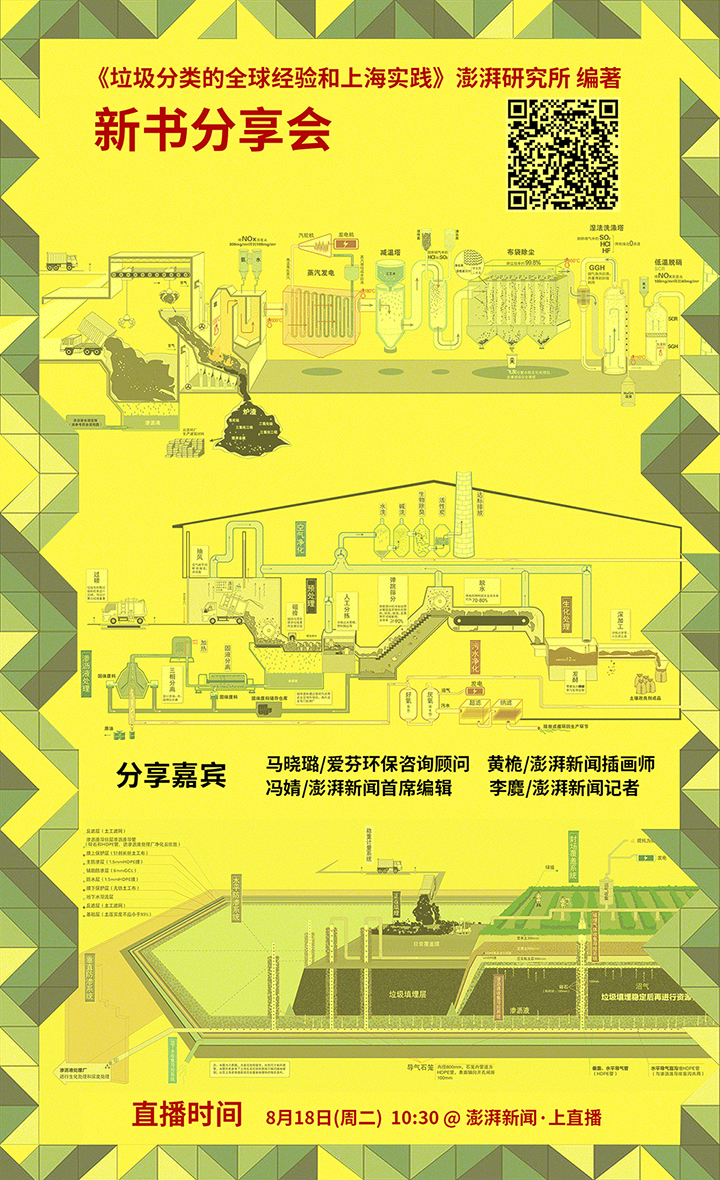To sum up, the community composting model in Bangalore is led by SWMRT, leading local public welfare organizations, social enterprises and volunteer groups to form a joint force, and it is a bottom-up attempt and promotion model. They took advantage of the opportunity brought by the garbage crisis to urge the state courts to issue decrees. Once the decrees were issued, they became a top-down promotion and implementation model. It can be said that Bangalore composting model is an organic combination of bottom-up and top-down methods, which provides a new idea for us to explore the technology and management path of kitchen waste recycling in China, especially to try and popularize community kitchen waste composting.
Below, some specific composting cases are introduced.
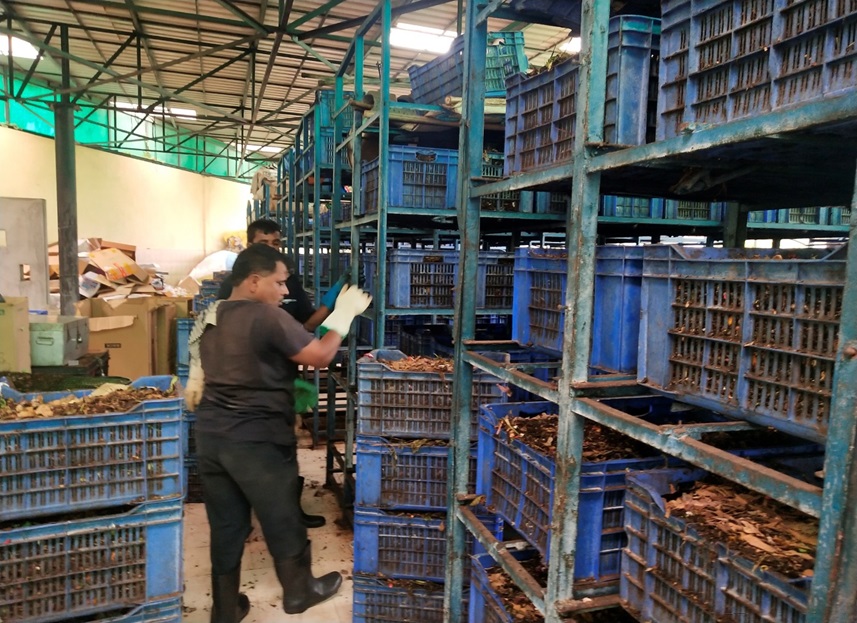
Compost basket in a community in Bangalore. The pictures in this article are provided by Zhang Xuehua.
There are 1332 households in this community, and composting has been done for more than seven years. They mixed kitchen waste, dried leaves, coconut residue (without strains), sawdust residue and a microbial strain, crushed them with a crusher and composted them. I call it shopping basket composting, which is the simplest and most economical community composting method. There are about 1000 baskets in this community, and the kitchen allowance is nearly 1000 kilograms a day. One box can hold about 13 kilograms of kitchen waste, and about 80-100 baskets are used every day, which can be recycled every 10 days. Ten days later, before being transferred from the shopping basket to the composting pool to continue fermentation, it will be broken again and screened, and the large particles will be put back into the next round of composting basket, and the small ones will enter the composting pool to continue fermentation. The whole composting process takes 35 to 40 days to complete.
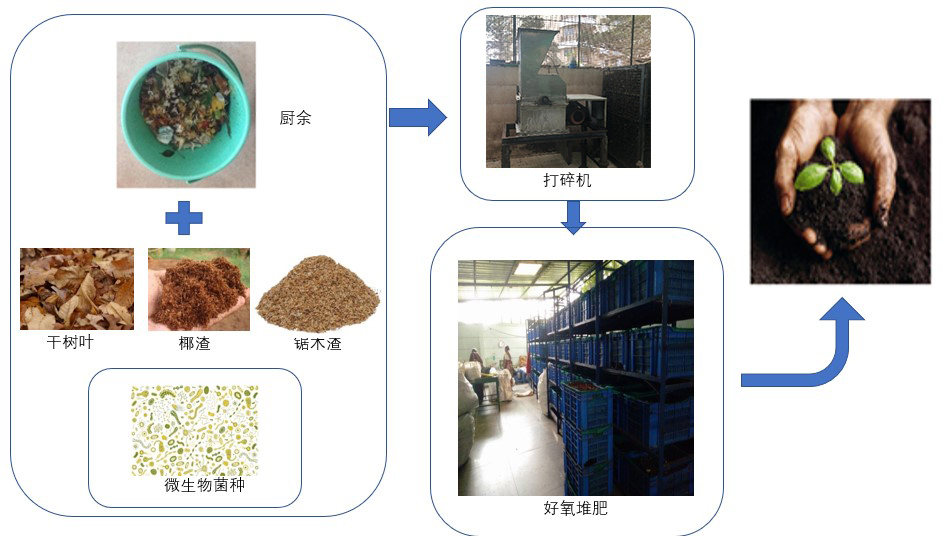
Schematic diagram of a composting process
The garbage disposal room in this community is about 300 square meters, which is not only used for composting, but also for secondary sorting of recycled garbage. Dry garbage can be sold for money, and so can kitchen waste. This place is managed by a woman from the Welfare Committee, and six workers are employed to take charge of the secondary sorting and composting management of garbage. Every morning from 10: 00 to 11: 30, the community cleaners come to collect garbage, and there are two people in one building. This meticulous management ensures the quality of the final fertilizer, and many local people are willing to buy their compost products.
Bokashi compost is also popular in China, which is very effective in treating mixed kitchen waste (raw, cooked and meat kitchen waste). The principle of Pocasi barrel is very simple, which is a facultative fermentation process dominated by anaerobic. However, if it is not properly managed, it is very easy to stink, especially during the transfer of fermented products, which often emits a lot of odor, causing residents to resent and complain.
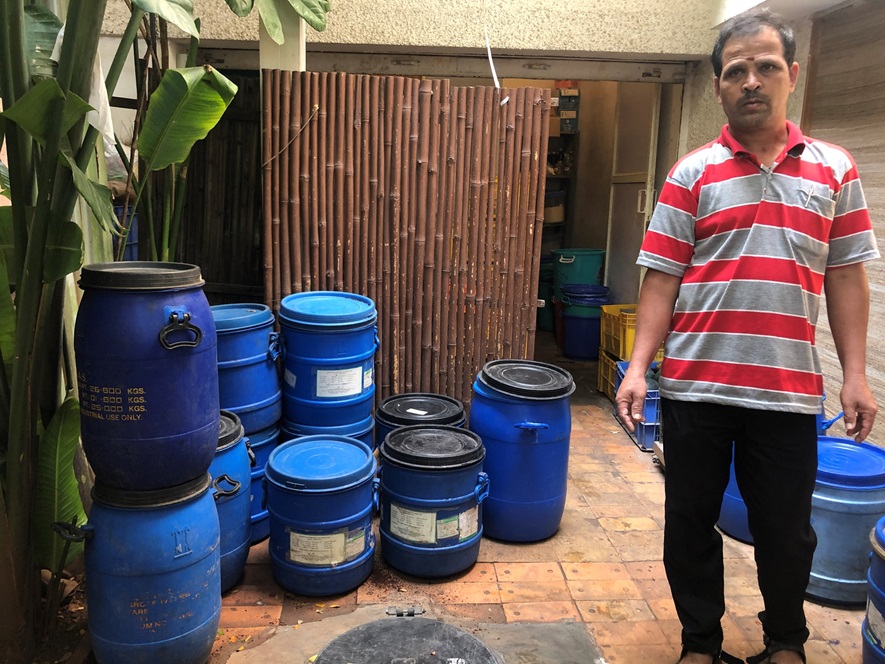
Pocasi bucket of the resort owner
This is a resort owner in Bangalore. He has three restaurants in the city. Every day, about 240 kilograms of kitchen waste is produced. Eight to ten bocasi barrels should be packed separately, and then coconut residue, bacteria and compaction should be added. After standing for three days, the barrels should be sent to the resort to continue fermentation for two weeks. Then transfer it out, add leaves for secondary aerobic composting, and complete the decomposition process after three to four weeks, and the compost product can be used.
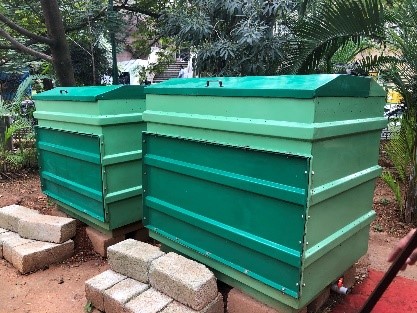
Sealed composting facilities in the office area of Bangalore municipal government
This is the composting facility in the office area of Bangalore municipal government. They started composting only two or three years ago. The cases mentioned before are all open composting, and the closed composting facilities are used here. They collect all the organic waste in the office area for composting, and also collect dry leaves as regulating substances for composting together. After fermentation, put it in a metal compost frame for decomposition. The quality of the final mature fertilizer is very good, and it is applied to the garden soil in the office area.
According to the Bangalore government’s estimate in early 2019 (the government has never had accurate statistics), about 50% of the residential quarters with a scale of more than 150 households in the city have been developing kitchen waste composting. So the question is, where did the remaining 50% of the kitchen waste go? According to the municipal official who received us, some went to government-certified composting companies, while others were buried in old quarries.
This shows that no matter how well laws and government policies are formulated, composting centers in many administrative districts have not been established. Frankly speaking, the local government still has the phenomenon of inaction, which exists in many countries and regions and depends on the continuous promotion of social forces.
Formation of composting industrial chain
Since Bangalore implemented the decentralized waste management model, we can see that a composting industry chain from design to sales has gradually taken shape. Local farmers began to be willing to use compost products piled up from kitchen waste, and companies specializing in purchasing and selling compost products appeared. The formation of industrial chain will also reduce the price of compost raw materials, such as coconut residue. The selling price of Indian coconut brick with bacteria is 25 yuan RMB for every 5 kg, and that of coconut brick without bacteria is 19 yuan RMB for every 5 kg. On the market in China, the online sales price of coconut bricks without bacteria is 23-25 yuan per 5 kg.
In recent years, the chain of urban kitchen waste compost and agricultural planting has begun to open up. Two years ago, the government tried to build a platform linking composting and planting, and recommended government-certified composting products to farmers. Because the government has not really promoted it, the platform has never been established. In 2019, SWMRT set up a platform of its own, and now it has settled in dozens of farms.
Due to the epidemic situation in COVID-19, many people don’t go to the supermarket to buy things, so the farmers’ market suddenly became prosperous, and more people began to buy compost products, which also brought closer the direct contact between community compost and farmers. It can be seen that it is very important to open up the circulation of substances and form a closed chain of organic substances.
Of course, government certification is also very important. At the end of last year, Bangalore government began to certify relevant composting enterprises, such as composting facilities manufacturers, composting raw materials enterprises and composting consulting companies. At present, 37 enterprises have obtained government qualifications. This is a measure taken by the government only after the composting industry has developed to a certain extent and promoted by social organizations. On the other hand, non-profit organizations like SWMRT themselves have hatched social enterprises and social organizations related to composting.
For example, Hasiru Dala is a well-known local charity organization concerned with garbage issues, and later it hatched a social enterprise with the same name, focusing on supporting the garbage collectors at the lowest level of society, striving for their legal employment status and related benefits from the government, providing them with technical training, allowing them to hold posts with certificates and helping to manage compost in various communities.
Daily Damp is the earliest local composting company. It was established in 2005, mainly selling composting facilities and various composting auxiliary products. In recent years, it began to acquire qualified composting products. The company invented the earliest closed compost bin, which was popular in India and even copied by Europeans and Americans. This company won the Best Social Enterprise Award in India in 2015.
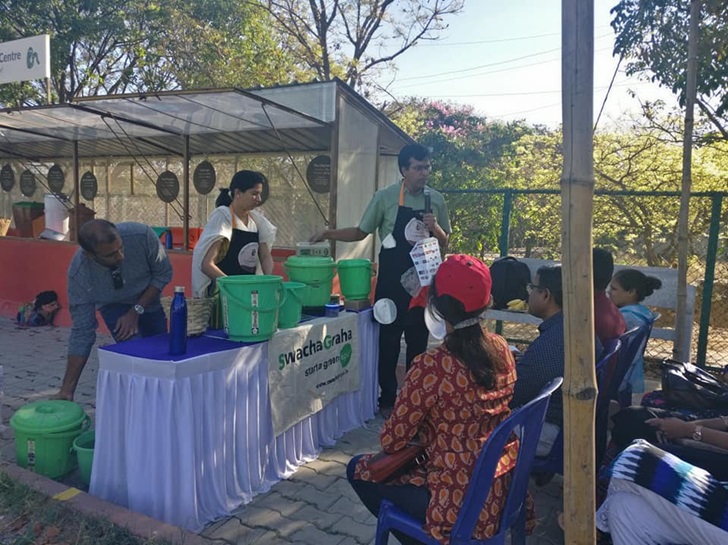
New Composting Learning Center in Bangalore: Social organizations are training residents on composting.
Since 2005, domestic composting has gradually emerged in Bangalore, laying an important mass foundation for community composting and centralized composting. For example, Vasuki, an Indian expert we hired, turned his garage into a warehouse for composting facilities, and the street in front of his house became a display place for composting, which can handle the kitchen waste of more than a dozen neighbors nearby.

Composting expert Vasuki’s composting company and home composting facilities are displayed.
We visited a public composting workshop that has been running for more than ten years. It is located in the home of Vani, a well-known local environmental activist. The activity venue is on the roof, and various composting methods are displayed in more than 100 square meters. For example, the simplest free self-made compost bucket can be composted by putting dried leaves picked up on the street and crushing them by hand.
What impressed me the most was that Vani told me repeatedly when we met for the first time that the best way to avoid mosquito odor from composting at home was to compost the kitchen waste as soon as it was produced. In other words, let the kitchen waste directly enter the compost bucket from the cutting board and dining table to avoid the rot and odor caused by long shelf life. In other words, the kitchen Yu Gang was not rotted when it was produced, and there were no mosquitoes, so it was the best to control.
In my opinion, the completion of the composting learning center is a landmark event for the success of community composting in Bangalore. The learning center was completed in early 2019. The municipal government took out a three-acre small park as a venue, and environmental protection organizations persuaded a local garbage collection and transportation company to provide financial support. This garbage company is run by the nephew of a district councilor in Bangalore. He donates one third of the company’s monthly income every year to maintain the operation and management of the learning center.
The reference significance of Bangalore
Source classification of kitchen waste is very important. Indian experts say that the purity of kitchen waste separated locally can reach 95%, which is related to door-to-door collection without plastic bags, with high visibility and less mixed impurities.
Secondly, the meticulous management of compost is very important, which is the most worth learning. They treat composting as a kind of science and art, strive to master the basic principles of composting, choose appropriate composting methods, and pay attention to the management of composting process. At the individual and community level, composting is the best way to practice circular economy.
There, I often heard the person in charge of the local environmental protection organization say: Treat your composting as your baby. Fine management in Bangalore can not only improve residents’ acceptance of composting and ensure the quality of composting products, but also gradually form an industrial chain and promote the popularization of community composting model.
In addition, Bangalore model can not be separated from the vigorous promotion of social forces and the participation of composting enterprises. For example, Vani, the "mother of compost" mentioned earlier, has been promoting home composting since 2005. Imagine that if 1% of families in a city have tried composting, then most people have heard of or seen composting, and composting has a certain social acceptance. By the time the garbage crisis appeared in 2012, more than a dozen local communities had formed a sustainable composting model, which was a very important prerequisite for the introduction and implementation of Bangalore’s new garbage policy.
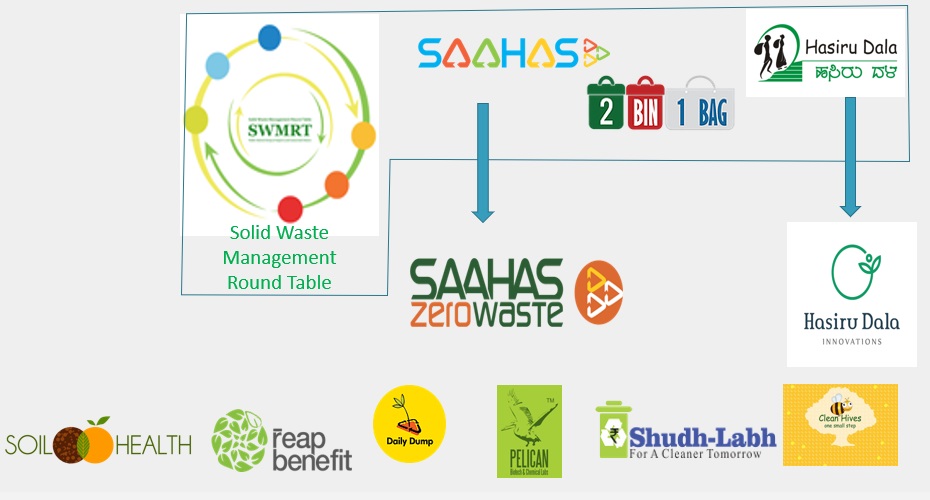
Social organizations and enterprises involved in composting promotion in Bangalore
Non-profit organizations not only promoted the introduction of policies (including public interest litigation), but also became the backbone of promotion after the introduction of policies, helping the government to improve mobilization and training work such as garbage sorting, kitchen waste composting and residents’ mobilization. Instead of waiting for the government to implement the policy, they actively helped the government to train volunteers and promote and supervise the government’s work. As we all know, it is very difficult to completely rely on the government’s conscious implementation.
In Bangalore, social organizations supported the emergence of composting industry from the beginning. Both the government and community organizations encouraged individuals to set up social enterprises to support the industry by supporting themselves. It is also very important that both communities and enterprises should make efforts to make the composting process and composting products safe and harmless, so as to ensure their application in public areas and farmland.
[Zhang Xuehua is the chief scientist of ecological environment research in Nanjing University (Lishui), and a doctor of interdisciplinary specialty in environment and resources in Stanford University. This article is based on a series of lectures of Zivanko Public Welfare Foundation on June 30th. 】

"Global Experience and Shanghai Practice of Garbage Sorting" compiled by the Institute of Surging has just come into the market. Please scan the QR code or follow the micro-stores of WeChat WeChat official account Archipelago and Tongji University Press, which are also available for sale on Dangdang.
